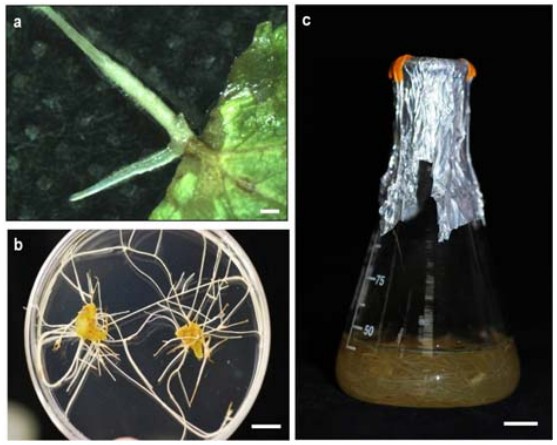Angelica gigas Nakai is a member of the Umbelliferae family and is easily recognized by its dark purple flowers; the Chinese and Japanese Angelica varieties have white flowers. Angelica gigas Nakai also has many pharmacological properties, such as the treatment of menopausal syndrome, anemia, and abdominal pain, in addition to inhibiting breast cancer and amenorrhea. As a highly valued medicinal plant, Angelica gigas Nakai is known for its therapeutic properties. It produces pyranocoumarins, including decursin and decursinol angelate, which have been found to have significant neuroprotective, anticancer, and anti-androgen receptor signaling activities. The genetic transformation of Angelica gigas has excellent potential to increase the production of these valuable metabolites and enhance their medicinal availability.
 Fig. 1. Development of hairy root from a leaf of A. gigas after inoculation with Agrobacterium rhizogenes R1601 containing GUS. (Park N I, et al, 2010)
Fig. 1. Development of hairy root from a leaf of A. gigas after inoculation with Agrobacterium rhizogenes R1601 containing GUS. (Park N I, et al, 2010)
Lifeasible is an industry leader in plant genetic transformation, providing comprehensive genetic transformation services for Angelica gigas Nakai. Our experts are also committed to exploring the Chinese and Japanese Angelica varieties genetic transformation. We offer customized transformation protocols tailored specifically for Angelica gigas, designed to optimize the efficiency and stability of transformation and ensure the reliable production of transgenic plants.
We offer Agrobacterium tumefaciens-mediated transformation services for Angelica gigas Nakai, covering key steps including:
Lifeasible provides tailored solutions and comprehensive services for Angelica gigas Nakai genetic transformation. By utilizing cutting-edge technology and customized solutions, we aim to generate Angelica gigas for you with desired traits or metabolites, such as the potential for enhanced pyranocoumarin biosynthesis. If you are interested in our solutions, please contact us for technical consultation and quotation.
Reference:
Park N I, Park J H, Lee C Y, et al. 'Agrobacterium Rhizogenes'-Mediated Transformation of [Beta]-Glucuronidase Reporter Gene in Hairy Roots of'Angelica Gigas' Nakai[J]. Plant Omics, 2010, 3(4): 115-120.